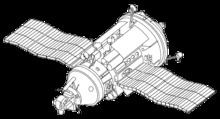Length 15 m Diameter 4.15 m Mass 20,000 kg Apogee 278,000 m Perigee 219,000 m | Reentry February 7, 1991 Width 16 m Launch date 27 September 1985 Orbital period 1.5 hours Perigee 219,000 m | |
 | ||
Similar Kosmos 1267, TKS, Kosmos 557, Salyut 7, Kristall | ||
Kosmos 1686 (Russian: Космос 1686 meaning Cosmos 1686), also known as TKS-4, was a heavily modified TKS spacecraft which docked unmanned to the Soviet space station Salyut 7 as part of tests to attach scientific expansion modules to stations in Earth orbit. The module which docked to the station was the FGB component of a TKS vehicle launched on September 27, 1985, and was designed to test systems planned for use on the Mir Core Module. The spacecraft docked with Salyut 7 on October 2, 1985, during the long-duration stay of the cosmonauts of its fifth principal expedition, which arrived on Soyuz T-14. It was the last flown TKS spacecraft.
Notable features
References
Kosmos 1686 Wikipedia(Text) CC BY-SA
